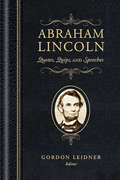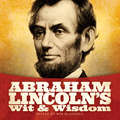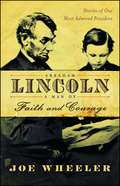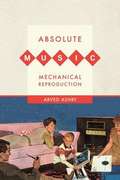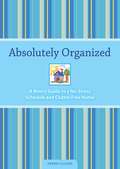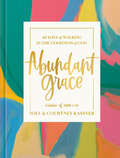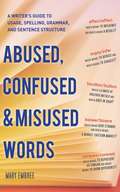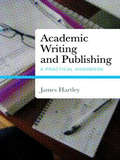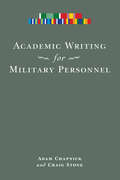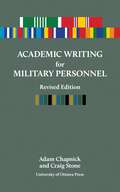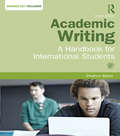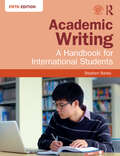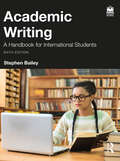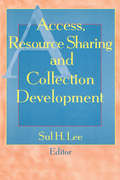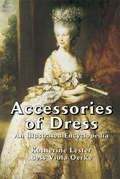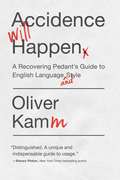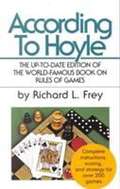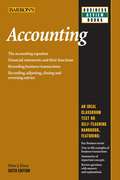- Table View
- List View
Abraham Lincoln Quotes, Quips, and Speeches
by Abraham Lincoln Gordon LeidnerMore than 140 years since his death, the enduring legacy of a great president, an American success story, and the celebrated leader of the Civil War continues. Abraham Lincoln: Quotes, Quips, and Speechescaptures the essence of the sixteenth president. In addition to Lincoln's own words, Gordon Leidner includes insights into the man by those who knew him best, from his wife, Mary Todd Lincoln, to his greatest political opponent, Stephen A. Douglas. Numerous photographs add to the charm and usefulness of the book.
Abraham Lincoln's Wit and Wisdom
by Bob Blaisdell"My politics are short and sweet, like the old woman's dance." The most eloquent of American presidents, Lincoln had a sagacious or humorous comment on everything that mattered. This attractively designed and illustrated gift book features the Great Emancipator's thoughts and opinions on subjects from politics to human nature to the burdens and privileges of the presidency.
Abraham Lincoln, a Man of Faith and Courage
by Joe WheelerHow Lincoln's Faith Shaped His Leadership Undoubtedly the most revered leader in American history, Abraham Lincoln has had more books written about him than all our nation's presidents put together. But for all that's been written, little has focused on his faith and how this quality shaped the man who led our country during its most tumultuous years. Author Joe Wheeler, historian and scholar, brings to the pages of this insightful book the knowledge gleaned from over ten years of study and more than sixty books on the life and times of Abraham Lincoln. Skillfully weaving his own narrative with direct quotes from Lincoln and poignant excerpts from other Lincoln biographers, Wheeler brings a refreshingly friendly rendition of Lincoln's life, faith, and courage. The stories, historical details, and powerful quotes on the pages of this book will leave a lasting impression on your heart, your mind, and your life.
Absolute Beauty: A Renowned Plastic Surgeon's Guide to Looking Young Forever
by Gerald ImberTwenty-five or sixty-five, we all want to look our vital, youthful best. The frustrating truth is that no matter how we wish it wasn't so, each day brings tiny changes, constantly chipping away at youth and beauty. Happily, with proper guidance most of this can be prevented, controlled, and reversed. It is a simple and sensible lifelong journey that will yield great rewards for all ages.Renowned plastic surgeon Dr. Gerald Imber changed the way men and women deal with aging in his books The Youth Corridor, which offered the first integrated strategy to control the signs of aging, and For Men Only, designed for the man who wants to stay trim and youthful but doesn't know where to turn for advice. Now, after vast improvements in science and surgery, Dr. Imber once again paves the way for people to find the path toward keeping their youthful appearance.In Absolute Beauty, Dr. Imber explores the new horizon for staying young-looking and the cutting-edge breakthroughs in areas such as:Minimally invasive facial surgeriesNew limited-incision faceliftsNew wrinkle fillersAnti-aging skin-care strategiesNew antioxidant strategiesAbsolute Beauty provides the crucial information needed to help you look your absolute best throughout your adult life. Dr. Imber's regimen will show you how to slow down the damage of time and help you turn back the clock. It will tell you how to protect your youthful good looks -- your absolute beauty -- by avoiding accelerating the changes that lead to aging and undoing the visible changes already present.This indispensable book covers all aspects of the modern cosmetic surgical experience and is a must-have guide for anyone considering plastic surgery or just wanting to stay young-looking.
Absolute Music, Mechanical Reproduction
by Arved AshbyIn this book, the author sees recordings as socially progressive and instruments of a musical vernacular, and argues that, just as photography redefined visual art, recording technology has transformed our understanding of art music.
Absolutely Organized
by Debbie LillardDo you run non-stop but never feel like you accomplish anything? Feel stressed out at home? Dream about doing things that you never get around to doing? Wish you had extra hours in your day? Well, here's something even better!Absolutely Organized is "a book full of tips and hope" for overworked, time-crunched, clutter-crushed moms. It's brimming with practical, proven and, in many cases, very simple solutions for keeping order in every corner of your life, from your refrigerator to your file drawers, from keeping a newborn on a set schedule to getting kids to willingly pitch in on household chores.Debbie Lillard, professional organizer and mother of three, shares her easy-to-use "Absolutes of Organizing" tips to help you gain and maintain order in the three key areas of your family's life:YOUR TIME: Learn the tricks for streamlining cleaning, laundry, grocery shopping and other everyday duties. Get more done and have more time left over to spend on your kids, your spouse, projects around the house, and even yourself!YOUR BELONGINGS: Use Debbie's simple but effective C.P.R. method (Categorize, Purge and Rearrange) to organize paperwork, photos, collections, toys, clothes, children's artwork and more.YOUR HOME: Take it room by room—home office, kitchen, bathroom, family room and even (gulp!) the kids' rooms. Rid your house of clutter, make the most of your space, and make home feel more comfortable, functional and relaxing.Follow Absolutely Organized from start to finish for a complete, full-life makeover. Or dip in here and there for help on one problem area at a time, such as that ever-growing mountain of paperwork, your collection of children's memorabilia, or that disaster area called a closet. Tried-and-true advice for every mom, Absolutely Organized will help you simplify your life so you can enjoy more and stress less.
Absolutely Organized: A Mom's Guide to a No-Stress Schedule and Clutter-Free Home
by Debbie LillardDo you run non-stop but never feel like you accomplish anything? Feel stressed out at home? Dream about doing things that you never get around to doing? Wish you had extra hours in your day? Well, here's something even better! Absolutely Organized is a book full of tips and hope for overworked, time-crunched, clutter-crushed moms. It's brimming with practical, proven and, in many cases, very simple solutions for keeping order in every corner of your life, from your refrigerator to your file drawers, from keeping a newborn on a set schedule to getting kids to willingly pitch in on household chores. Debbie Lillard, professional organizer and mother of three, shares her easy-to-use Absolutes of Organizing tips to help you gain and maintain order in the three key areas of your family's life: YOUR TIME: Learn the tricks for streamlining cleaning, laundry, grocery shopping and other everyday duties. Get more done and have more time left over to spend on your kids, your spouse, projects around the house, and even yourself! YOUR BELONGINGS: Use Debbie's simple but effective C. P. R. method (Categorize, Purge and Rearrange) to organize paperwork, photos, collections, toys, clothes, children's artwork and more. YOUR HOME: Take it room by room-home office, kitchen, bathroom, family room and even (gulp!) the kids' rooms. Rid your house of clutter, make the most of your space, and make home feel more comfortable, functional and relaxing. Follow Absolutely Organized from start to finish for a complete, full-life makeover. Or dip in here and there for help on one problem area at a time, such as that ever-growing mountain of paperwork, your collection of children's memorabilia, or that disaster area called a closet. Tried-and-true advice for every mom, Absolutely Organized will help you simplify your life so you can enjoy more and stress less.
Abundant Grace: 40 Days of Walking in the Goodness of God: A Devotional
by Will Kassner Courtney KassnerFrom the creators of Crew + Co. comes a gorgeous 40-day devotional resource that will inspire reflection and encourage Christian creatives to make Scripture reading a daily practice in their lives.Abundant Grace, the debut devotional from Crew + Co. founders Courtney and Will Kassner, invites creative believers to meditate on and engage with Scripture daily, with devotions that are accessible, beautifully designed, and deeply encouraging. Divided into three parts—Knowing God's Grace, Trusting God's Grace, and Showing God's Grace—this forty-day devotional guides you in recognizing the small moments of grace around you and teaches you how to cultivate a grace-filled perspective in even the busiest lifestyle.Each of the forty days pairs a full-color hand-lettered Bible verse with a thoughtful devotion that closes with either a prayer or a reflection question for helping you recognize how God&’s grace works in your normal, everyday life.
Abused, Confused, and Misused Words: A Writer's Guide to Usage, Spelling, Grammar, and Sentence Structure
by Mary EmbreeHave you been putting bullion in your soup? Is incorrect spelling starting to have a negative affect on your term papers? Do you wonder what someone is inferring when they tell you to pick up a dictionary? These are just a few of the commonly misunderstood words discussed and explained in Abused, Confused, and Misused Words, an entertaining and informative look at the ever-changing nature of the English language. An alphabetical list of words that are frequently misspelled or misused is accompanied by a style guide to usage rules that tells you how and why they can be broken. Also included is a collection of 1,000 new and inventive words, and nearly 30,000 more words are discussed in a section dealing with word roots and how they are used in modern language. Anyone who is intrigued by language, who is fascinated by words, or who simply wants to use our language clearly and effectively will enjoy this delightful, eye-opening collection.
Academic Writing and Publishing: A Practical Handbook
by James HartleyAcademic Writing and Publishing will show academics (mainly in the social sciences) how to write and publish research articles. Its aim is to supply examples and brief discussions of recent work in all aspects of the area in short, sharp chapters. It should serve as a handbook for postgraduates and lecturers new to publishing. The book is written in a readable and lively personal style. The advice given is direct and based on up-to-date research that goes beyond that given in current textbooks. For example, the chapter on titles lists different kinds of titles and their purposes not discussed in other texts. The chapter on abstracts instructs the reader on writing structured abstracts from the start.
Academic Writing for Military Personnel
by Adam Chapnick Craig StoneAcademic Writing for Military Personnel is written for members of the military who are either new to or re-entering the academic community and who need to familiarize themselves with academic writing. The authors, an experienced writing instructor and a retired military officer, show how persuasive academic writing enhances officers’ effectiveness in their regular duties, especially as they reach more senior levels of service. They explain the differences between staff writing and academic writing, and outline some of the common errors military personnel make when transitioning from one to the other. The book’s chapters outline the value of strong written communication skills, the research process, the writing process, academic referencing, and frequent grammatical and syntactical errors. Specific examples chosen with a military audience in mind are integrated throughout the book to provide the reader with relevant and practical guidance. The book concludes with a discussion on how officers can use the knowledge they have acquired through their professional experiences in their academic work. As the only comprehensive guide to effective academic writing designed specifically for military personnel, this book will be a crucial addition to the libraries of junior and senior officers in militaries worldwide.
Academic Writing for Military Personnel, revised edition: Revised Edition (Standalone titles)
by Adam Chapnick Craig StoneAcademic Writing: A Guide for Military Personnel est un manuel de rédaction conçu pour aider le personnel militaire à rédiger des travaux savants dans un style clair et efficace. Fruit de la collaboration entre un professeur d’écriture chevronné et un officier militaire à la retraite, le manuel s’adresse aux membres des forces armées qui rejoignent le monde universitaire et qui ont déjà rédigé dans un contexte professionnel militaire ou qui n’ont aucune expérience de la rédaction. En plus d’enseigner aux officiers comment rédiger efficacement, cet ouvrage explique en quoi la maîtrise des techniques de rédaction est utile au personnel des forces armées dans leurs tâches régulières, en particulier aux échelons supérieurs. L’ouvrage traite de l’importance de savoir communiquer par écrit, de ce qui distingue la rédaction savante de la rédaction professionnelle, des processus de recherche et de rédaction proprement dite, du professionnalisme dans la sphère universitaire ainsi que des problèmes et défis fréquemment rencontrés par les rédactrices et les rédacteurs. Un dernier chapitre novateur traite de la manière dont les officiers peuvent mettre à profit les connaissances qu’ils ont acquises par leurs expériences professionnelles dans le contexte universitaire. Des exemples concrets — à l’usage particulier des militaires — sont présentés tout au long du texte pour guider la lectrice et le lecteur de manière pratique et pertinente.Cette édition révisée comprend de nouveaux exemples provenant d’une plus grande variété d’auteurs. Elle prend en compte l’évolution récente des technologies de communication et reflète les nouvelles avancées dans les domaines de l’enseignement et de l’apprentissage.Cet ouvrage, qui est le seul guide exhaustif sur la rédaction à l’usage du personnel militaire, est un ajout incontournable à la bibliothèque de tout officier militaire où qu’il se trouve et quel que soit son rang.Ce livre est publié en anglais. Note : Une version française de ce livre sera disponible en 2023.Formats disponibles : couverture souple, PDF accessible et ePub accessible
Academic Writing: A Handbook for International Students
by Stephen BaileyMost international students need to write essays and reports for exams and coursework, but writing good academic English is one of the most demanding tasks students face. This new, fourth edition of Academic Writing: A Handbook for International Students has been completely revised to help students reach this goal. The four main parts of Academic Writing are: The writing process Elements of writing Vocabulary for writing Writing models Each part is divided into short units which contain examples, explanations and exercises, for use in the classroom or for self-study. The units are clearly organised to allow teachers and students find the help they need with writing tasks, while cross-referencing allows easy access to relevant sections. In the first part, each stage of the writing process is demonstrated and practised, from selecting suitable sources, reading, note-making and planning through to re-writing and proof-reading. The fourth edition of this popular course builds on the success of the earlier editions, and has a special focus on the vital topic of academic vocabulary in part three, Vocabulary for Writing. Part three deals with areas such as nouns and adjectives, adverbs and verbs, synonyms, prefixes and prepositions, in an academic context. More key features of the book include: All elements of writing are clearly explained, with a full glossary for reference Models provided for all types of academic texts: essays, reports, reviews and case-studies Full range of practice exercises, with answer key included Use of authentic academic texts A companion website offers further practice with a range of additional exercises Fully updated, with sections on finding electronic sources and evaluating internet material All international students wanting to maximise their academic potential will find this practical and easy-to-use book an invaluable guide to writing in English for their degree courses.
Academic Writing: A Handbook for International Students
by Stephen BaileyNow in its fifth edition, Academic Writing helps international students succeed in writing essays and reports for their English-language academic courses. Thoroughly revised and updated, it is designed to let teachers and students easily find the topics they need, both in the classroom and for self-study.The book consists of five parts: The Writing Process Elements of Writing Language Issues Vocabulary for Writing Writing Models The first part explains and practises every stage of essay writing, from choosing the best sources, reading and note-making, through to referencing and proofreading. The four remaining parts, organised alphabetically, can be taught in conjunction with the first part or used on a remedial basis. A progress check at the end of each part allows students to assess their learning. All units are fully cross-referenced, and a complete set of answers to the practice exercises is included.New topics in this edition include Writing in Groups, Written British and American English, and Writing Letters and Emails. In addition, the new interactive website has a full set of teaching notes as well as more challenging exercises, revision material and links to other sources. Additional features of the book include: Models provided for writing tasks such as case studies and essays Use of authentic academic texts from a wide range of disciplines Designed for self-study as well as classroom use Useful at both undergraduate and postgraduate level Glossary to explain technical terms, plus index Written to deal with the specific language issues faced by international students, this practical, user-friendly book is an invaluable guide to academic writing in English.
Academic Writing: A Handbook for International Students
by Stephen BaileyThe new sixth edition of this popular book has been written to help international students succeed in writing essays and reports for their English-language academic courses. Thoroughly revised and updated in a streamlined format making it even easier for students and teachers to use, Academic Writing: A Handbook for International Students is designed to let readers find the support they need easily, both in the classroom and for self-study.The book consists of three parts, comprising a total of 28 units: The Writing Process and Writing Skills; Elements of Writing; and Writing Models. The first part explains and practises every stage of essay writing, from choosing the best sources, reading and note-making, through to referencing and proofreading. These stages are supported by relevant explanations of critical writing skills, so that, for instance, finding synonyms is linked with paraphrasing and summarising. The second part explains critical issues such as using numbers and punctuation, and is organised alphabetically, while the third part provides models for common components of student writing such as case studies and reports. All units are fully cross-referenced and can be taught in conjunction with each other or used for self-study or reference. A progress check at the end of each part allows students to self-assess their learning, and a complete set of answers to the practice exercises is included.Additional features of the book include: Use of authentic academic texts from a wide range of disciplines Designed for self-study as well as classroom use Useful at both undergraduate and postgraduate level Fully updated, with sections on using AI and exploring electronic sources Access to the free interactive website which includes a full set of teaching notes as well as more challenging exercises, revision material and links to other sources. All international students wanting to maximise their academic potential will find this practical and easy-to-use book an invaluable guide to writing in English for their degree courses.
Acceptable Methods of Aircraft Inspections and Repair: AC 43.13-1B/2B
by Federal Aviation AdministrationThis advisory circular (AC) contains methods, techniques, and practices acceptable to the Administrator for the inspection and repair of nonpressurized areas of civil aircraft, only when there are no manufacturer repair or maintenance instructions. This data generally pertains to minor repairs. The repairs identified in this AC may only be used as a basis for FAA approval for major repairs.
Access to History for the IB Diploma: Rights and protest
by Peter Clements Michael Scott-BaumannA new book for Paper 1, Prescribed Subject 4: Rights and Protest The renowned IB Diploma History series, combining compelling narratives with academic rigor. An authoritative and engaging narrative, with the widest variety of sources at this level, helping students to develop their knowledge and analytical skills. Provides: - Reliable, clear and in-depth content from topic experts - Analysis of the historiography surrounding key debates - Dedicated exam practice with model answers and practice questions - TOK support and Historical Investigation questions to help with all aspects of the Diploma
Access to Justice in Transnational B2C E-Commerce: A Multidimensional Analysis of Consumer Protection Mechanisms
by Sutatip YuthayotinThis book identifies institutional mechanisms that can be used to promote consumer confidence in direct online sales with businesses (B2C e-commerce). It argues that enhancing the access to justice in a multidimensional sense can potentially offer an effective means of boosting consumer confidence. It introduces a conceptual framework for a multidimensional approach to access to justice in the context of consumer protection, describing the various reasonable criteria needed to satisfy consumer demands in B2C e-commerce. The framework, which reflects all essential aspects of consumers' expectations when they engage in online transactions, provides a benchmark for the evaluation of various consumer protection mechanisms. Based on an analysis of different mechanisms and using the framework's criteria, the practice of private ordering, which does not rely on the creation of rules of law but rather on the use of technology as a solution, appears to offer a meaningful way to enhance access to justice in B2C e-commerce. However, though private ordering holds considerable potential, certain weaknesses still need to be eliminated. This book demonstrates how private ordering can be successfully implemented with the help of an intermediary, a neutral third party that plays an integral part in the collaborative task of facilitating various aspects of private ordering, thus helping to limit the risks of failure and ensuring a fairer market setting. In order to move forward, it argues that the state, with its wealth of material resources and incentive options, is the institution best suited to acting as an intermediary in facilitating private ordering. This promising proposal can improve consumer protection, which will in turn boost consumer confidence.
Access, Resource Sharing and Collection Development
by Sul H LeeAccess, Resource Sharing, and Collection Development explores the role of libraries in acquiring, storing, and disseminating information in different formats to help you better use technology to share scarce resources and connect library users with collections. With an expressed goal of encouraging continued debate and further investigation, this book provides you with developing strategies and procedures to meet the challenges you face as a collection development librarian during this dynamic time. Among the vital concerns addressed are the competition for limited resources, trends in document delivery, the evaluation of document delivery products, and libraries’options for the future.The chapters collected in Access, Resource Sharing, and Collection Development represent the proceedings of the annual conference held by the University of Oklahoma Libraries and the University of Oklahoma Foundation. The book provides insight into your peers’findings and ideas on: access vs. ownership the future role of the bibliographer changes in collection management managing restrained resource budgets an emphasis on the library user as customer the growth and acceptance of document delivery as a component of collection development and ILL electronic publishing and copyright issues commercial document delivery services Access, Resource Sharing, and Collection Development also shows you how to discover and evaluate "free" resources on the Internet, as standards for production, promotion, and maintenance are nonexistent. The challenge of using these materials is being met by developing criteria for selection, looking at cataloging options, and working in cooperation with other institutions. You’ll also learn the different options for document delivery and how to evaluate document delivery products. Among the book’s advice: you should consider the types of document delivery available, examine the benefits of combining outside services with in-house systems, review the criteria for selecting technologies and suppliers, and explore examples of institutions creating customized systems.
Accessibility Guidelines and Standards for Higher Education Institutions and Universities
by Ministry of Education University Grants CommissionAccessibility Guidelines and Standards for Higher Education Institutions and Universities is a transformative book that delves into the realm of higher education and the inclusion of persons with disabilities. Drawing upon the guidelines and standards set by the University Grants Commission (UGC), the book explores the imperative need for accessible mechanisms in Higher Educational Institutions (HEIs) and Universities. It delves into the United Nations Convention on the Rights of Persons with Disabilities (RPWD) Act and the National Education Policy (NEP) 2020, emphasizing their role in promoting inclusive education. Through comprehensive coverage of diverse aspects, including support provision, accessible resources, inclusive infrastructure, curriculum adaptation, and assessment systems, the book provides practical insights for HEIs to develop an inclusive environment. Additionally, it highlights the importance of inclusive campus life, governance, and monitoring to foster an empowering educational journey for persons with disabilities. Accessibility Guidelines and Standards for Higher Education Institutions and Universities is a guiding light for educators, administrators, policymakers, and advocates seeking to create a truly inclusive higher education landscape.
Accessible E-Content Creation Standards and Guidelines
by Bookshare XrcvcThis document/book lists the standards of and provides guidelines on creating accessible e-content from Mircosoft Word. These standards are intended to help NGOs, libraries, book production agencies and volunteers prepare a digital copy of books in Microsoft Word with a view to further convert it to accessible formats such as EPUB, accessible PDF and DAISY formats with minimal modifications.
Accessories of Dress: An Illustrated Encyclopedia
by Bess Viola Oerke Katherine LesterDrawing upon a vast number of historical sources, the authors of this useful reference have created an entertaining account of the forms of personal adornment men and women have used throughout the ages to enhance their wearing apparel. From hats, veils, wigs, and cosmetics, to cravats, shawls, shoes, and gloves, to walking sticks, handbags, fans, and furs, the engaging commentary displays the humor and personal charm of the many-sided story of accessorized apparel. 644 figures and 59 plates.
Accidence Will Happen: A Recovering Pedant's Guide to English Language and Style
by Oliver KammA witty, authoritative, and often provocative guide to the use and abuse of the English language, by the London Times's lead grammar columnist. Are standards of English alright—or should that be all right? To knowingly split an infinitive or not to? And what about ending a sentence with preposition, or for that matter beginning one with "and"? We learn language by instinct, but good English, the pedants tell us, requires rules. Yet, as Oliver Kamm cleverly demonstrates in this new book, many of the purists' prohibitions are bogus and can be cheerfully disregarded. Accidence Will Happen is an authoritative and deeply reassuring guide to grammar, style, and the linguistic conundrums we all face.
According To Hoyle
by Richard L. FreyOFFICIAL RULES OF MORE THAN 200 POPULAR GAMES OF SKILL AND CHANCE WITH EXPERT ADVICE ON WINNING PLAY
Accounting (Barron's Business Review Series)
by Peter J. Eisen<p>Like the other titles in Barron’s Business Review Series, the new sixth edition of Accounting makes a useful supplement to college textbooks, and is also excellent as a main text in business brush-up programs. Author Peter J. Eisen familiarizes students with key accounting terms, explains the accounting equation, and goes on to instruct in the use and preparation of financial statements, the recording of business transactions in journals, and in closing and adjusting entries at the end of a business period. <p>The book is organized to closely follow a standard college textbook, but concentrates on student understanding of what is done, and, more importantly, how and why. Other helpful features include: Review questions; Computational problems with complete detailed solutions presented when appropriate; Additional problems to reinforce the reader’s knowledge; An extensive glossary of accounting terms. <p>New features in this edition include instruction in the use of spreadsheets to solve many accounting problems, a more detailed explanation of accounting data procedures as internal controls designed to safeguard assets, and extensive commentary on business ethics.</p>
